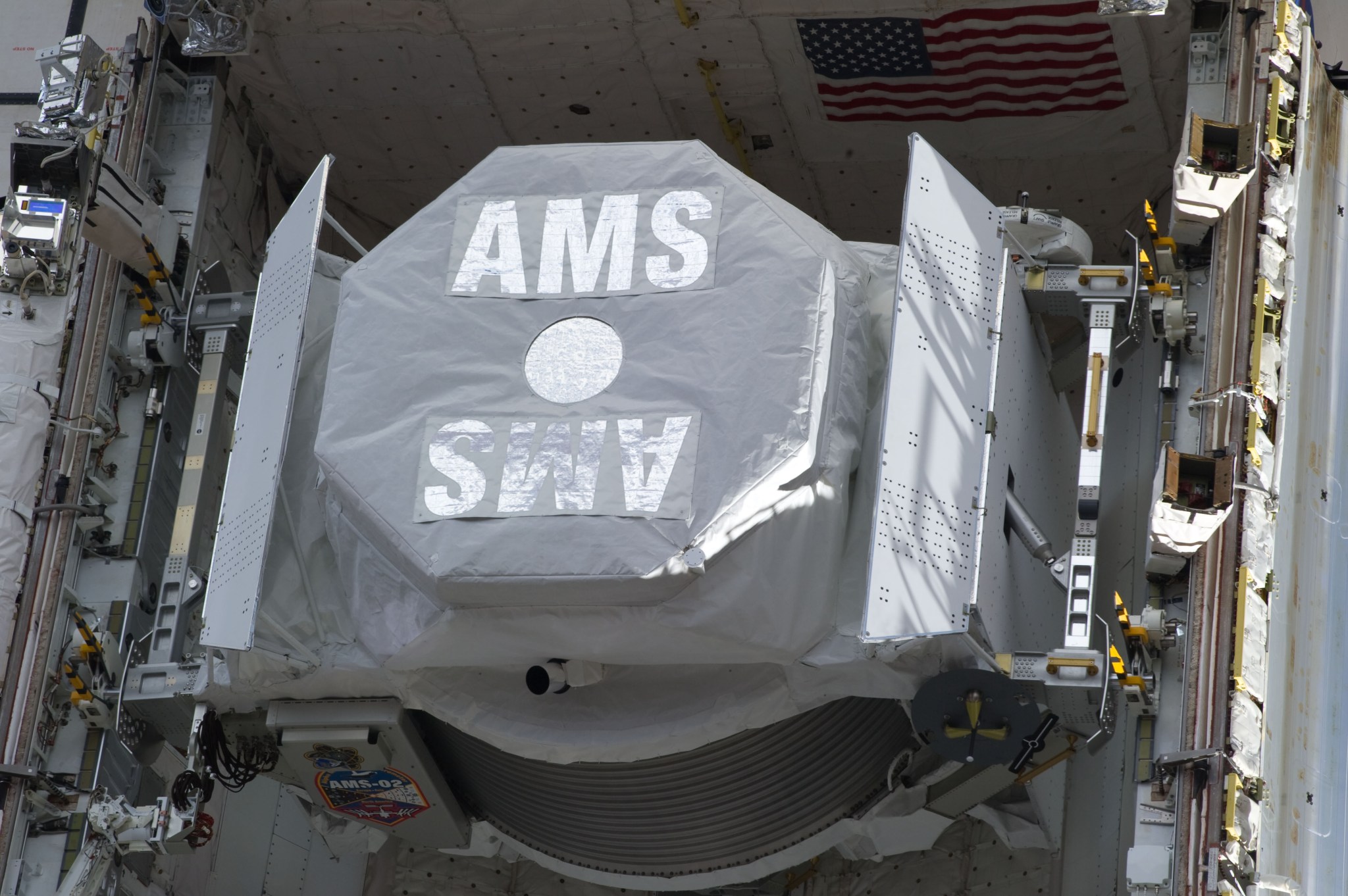The Alpha Magnetic Spectrometer project began in 1994, when Professor Samuel Ting, a Nobel Laureate from the Massachusetts Institute of Technology was considering a new high-energy physics experiment. The concept of an International Space Station had just been announced in 1993, and Ting and his collaborators saw an opportunity for groundbreaking science in space. So, this group of particle physicists called The Antimatter Study Group published the concept for “An Antimatter Spectrometer in Space.” The United States Department of Energy agreed to sponsor the project, NASA agreed to put it in space, and the AMS team grew.
To prove the concept, an early version of AMS spent 10 days in space aboard the space shuttle Discovery in 1998. In the 103 hours that the experiment was turned on, the AMS collected data for nearly 100 million cosmic rays. The data gathered provided the first accurate measurement of the composition of primary cosmic rays, and seven scientific papers were published.
Work on the current version of the AMS began in 1998, and was finished and shipped from CERN – the European Organization for Nuclear Research – in Geneva to Kennedy Space Center in Florida in August 2010. The space shuttle Endeavour carried it into orbit in May 2011, when it was installed on the station’s truss structure and has been measuring particles ever since.
ELEMENTS
The AMS is composed of a magnet and eight detectors that provide the scientists on the ground with information about the particles that travel through the magnet. All of the information is collected in the nanoseconds it takes a particle to travel through the AMS, and then sent down to scientist on the ground for analysis.
The Magnet
At the center – and the heart – of the AMS is the Permanent Magnet. Without it, cosmic particles would fly directly through the detectors in a straight line, offering no clues as to their charge. The Permanent Magnet, which also flew on space shuttle Discovery in the early version of the AMS experiment, is a 1.105 meter by 0.8 meter cylinder made up of more than 6,000 2-by-2-by-1-inch blocks of Neodymium-Iron-Boron glued together with epoxy. Neodymium-Iron-Boron magnets are the strongest permanent magnets, providing the AMS with a magnetic field 3,000 times stronger than that of the Earth. However it does not draw the cosmic particles to the International Space Station. In fact, the magnetic draw is not felt at all, outside of the AMS – otherwise it might change the space station’s orientation or draw astronauts to it on spacewalks.
Instead, it takes advantage of the cosmic particles already traveling in the space station’s path, and bends their trajectory as they pass through the magnet. The direction of the curve will provide the scientists on the ground with information about the charge of the particle (whether it is positive or negative). The Permanent Magnet’s strength should last through 2020 – the planned life of the space station – and beyond.
The Transition Radiation Detector
The first detector that a particle will pass through as it enters the AMS is the Transition Radiation Detector (TRD). The TRD has the ability to distinguish between electrons and protons by detecting X-rays emitted by some particles.
The TRD is made of 328 modules, arranged in 20 layers. Each module contains 16 straw tubes filled with a Xenon-rich gas mixture and 20 millimeters of radiator made of polypropylene/polyethylene fiber fleece. When an electron passes through these layers, it will emit an X-ray. Protons will not.
On the other hand, positrons – the antimatter counterpart of electrons – will emit an X-ray. Positrons have the same mass as an electron, but a positive charge, like a proton. The TRD will allow scientists to tell protons and positrons apart in the search for antimatter.
The Time-of-Flight Detectors
The two Time-of-Flight (ToF) detectors (one at the top of the magnet and one at the bottom) act as the AMS’s stopwatch. When one is triggered by a particle entering the magnet, it starts the other detectors; when the particle exits from the opposite side, the other detectors stop.
The ToF can also provide scientists information on the direction a particle is traveling, which is important for antimatter identification, as electrons can be mistaken for their positron counterparts, if one does not know the direction of a particle. And it assists in identifying the charge of a particle, which will help scientists determine which element a particle is.
Each of the ToF detectors is made up of two scintillation counters. (Scintillation is a flash of light created when a particle going through the ToF emits a photon.) The top and bottom ToFs are about 4 feet apart and are precise down to 150 picoseconds. This allows the detectors to measure particles traveling at speeds up to 98 percent of the speed of light.
The Silicon Trackers
Without the magnet, particles would travel in a straight line through the AMS, but without the silicon trackers, we would not know the difference. There are nine tracker planes arranged throughout the AMS – one at the top, one at the bottom, and seven within the magnet. Each of them works together to provide data on the curvature of the trajectory a particle takes through the AMS, as it is influenced by the magnet: A positively charged particle will curve in the opposite direction of a negatively charged particle. This information, when combined with the information provided by the other detectors, allows scientists to distinguish between matter and antimatter.
The tracker panels are made of 2,264 double-sided silicon sensors, with a total of 200,000 sensor channels. The trackers require their own radiator to keep them cool.
The Tracker Alignment System
Because the curvature of the particles is so crucial to the AMS experiment, it is important to know that the tracker panels are measuring the particles’ paths accurately. To do so, they must be precisely aligned, or corrections must be made for any misalignment they might experience in space. Otherwise, what looks like a particular curve could actually be caused by a particle moving through misaligned trackers.
The Tracker Alignment System monitors the positions of the trackers themselves, using 20 (10 going up and 10 going down) straight laser beams that mimic the tracks of particles. It is able to detect changes in the tracker positions of down to five micrometers or less.
The Anti-Coincidence Counter
Although cosmic particles will enter the AMS from all angles, only the ones that enter from the top and exit at the bottom are certain to make it through all of the AMS detectors. The instruments will not be able to gather all the necessary information on the other eight-tenths of the particles, and the extra particles traveling in abnormal directions can confuse the silicon trackers.
So, rather than gather incomplete information and risk spoiling the data on the desirable particles, the Anti-Coincidence Counters act as the ToF detector for these rogue particles, but for the opposite reason – rather than turning on the other detectors when a particle passes through it, it tells them not to track the particle.
The Ring Imaging Cherenkov Detector
One of the distinguishing characteristics of a particle is its mass, however, the AMS has no instrument that measures a particle’s mass. Instead, the mass is determined indirectly using a formula that requires the particle’s curvature, its charge and its speed. The Ring Imaging Cherenkov (RICH) detector provides the speed part of the equation.
The RICH is named for and makes use of the Cherenkov Effect, which describes the way particles that are traveling at a speed somewhere between the speed of light in a vacuum and the speed of light through glass emit cones of light when they travel through certain mediums – in this case, the RICH’s radiator. The cone of light can take the shape of a circle or an ellipse, and the shape can be used to determine the particle’s speed.
The RICH is made up of a radiator plane, a conical mirror and a photon detection plane.
The Electromagnetic Calorimeter
To determine the energy of the particles passing through the AMS, the Electromagnetic Calorimeter (ECAL) was added. The ECAL is a 3-by-3-by-.75-foot block of lead with thousands of fiberoptic lines running through it. Depending on the energy of a particle, when it passes through lead, it may break up and produce an electromagnetic shower or a hadronic shower. The shapes of the two showers are very different, and from the shape, scientist can pick out the one positron from as many as 100,000 protons, or one antiproton from 100 electrons.
The ECAL is made up of nine super-layers, each of which contains 11 leaves of thick lead foil alternating with layers of scintillating fibers, glued together.
Electronics
The AMS uses about 300,000 electronics channels to provide power to the detectors and record the data they collect.
The AMS computers were specifically designed and tested for space applications, so every piece of electronics, including each computer, on the AMS is at least 10 to 100 times faster than any available aerospace component. The experiment will gather more than seven gigabits of data, per second. That data will then be analyzed, compressed by 650 computers onboard the experiment and readied for transmission to Earth at approximately thirteen megabits per second.
The Star Trackers and GPS
To correlate the findings of the AMS with those of other scientific instruments in space, it is important to know where the AMS is looking as it gathers its information. To track its position and the direction it’s pointing, the AMS has two Star Trackers (pointed in different directions, so that when one is pointing at the sun and therefore blinded, the other can still provide information) and a GPS receiver. The Star Trackers will take one photo of the sky in a 6-degree field-of-view per second. The photos can then be compared to stellar maps to determine the AMS’s orientation. This kind of information is also gathered in analyses of down-linked space station vehicle telemetry.
The GPS antenna is fixed on the top of the Transition Radiation Detector, and the receiver is on top of the AMS.
Team
Led by Principle Investigator and Spokesperson Samuel Ting of the Massachusetts Institute of Technology, the AMS team includes some 600 physicists from 56 institutions in 16 countries from Europe, North America and Asia. The various participants built their particular contributions, which were all integrated when the AMS was built at CERN in Geneva.
During the STS-134 mission and for the first several months afterward, about 40 members of the AMS team monitored the experiment and analyzed the data it sent down from the Payload Operations Control Center at Johnson Space Center in Houston. In July of 2011, the AMS operations moved back to CERN, where the AMS team continues monitoring and controlling the experiment 24 hours a day, with the capability to gather data for as long as the space station is in orbit.
For more information about the AMS experiment and collaboration visit:
http://www.ams02.org/
10 min read
























